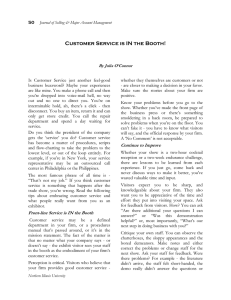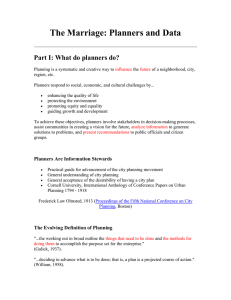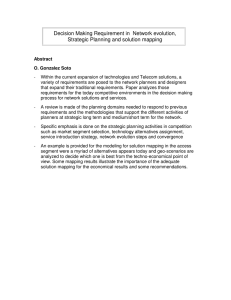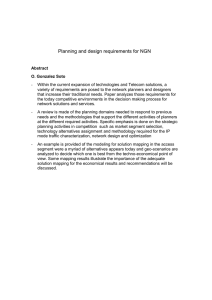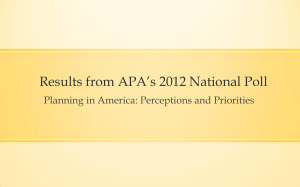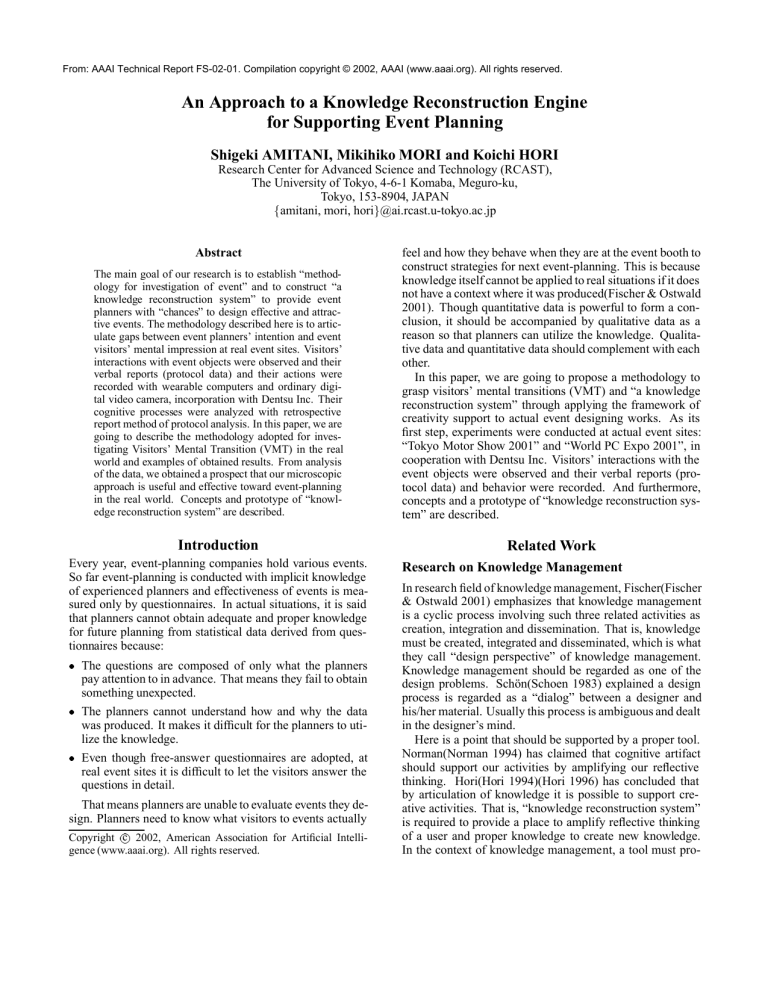
From: AAAI Technical Report FS-02-01. Compilation copyright © 2002, AAAI (www.aaai.org). All rights reserved.
An Approach to a Knowledge Reconstruction Engine
for Supporting Event Planning
Shigeki AMITANI, Mikihiko MORI and Koichi HORI
Research Center for Advanced Science and Technology (RCAST),
The University of Tokyo, 4-6-1 Komaba, Meguro-ku,
Tokyo, 153-8904, JAPAN
famitani, mori, horig@ai.rcast.u-tokyo.ac.jp
Abstract
The main goal of our research is to establish “methodology for investigation of event” and to construct “a
knowledge reconstruction system” to provide event
planners with “chances” to design effective and attractive events. The methodology described here is to articulate gaps between event planners’ intention and event
visitors’ mental impression at real event sites. Visitors’
interactions with event objects were observed and their
verbal reports (protocol data) and their actions were
recorded with wearable computers and ordinary digital video camera, incorporation with Dentsu Inc. Their
cognitive processes were analyzed with retrospective
report method of protocol analysis. In this paper, we are
going to describe the methodology adopted for investigating Visitors’ Mental Transition (VMT) in the real
world and examples of obtained results. From analysis
of the data, we obtained a prospect that our microscopic
approach is useful and effective toward event-planning
in the real world. Concepts and prototype of “knowledge reconstruction system” are described.
feel and how they behave when they are at the event booth to
construct strategies for next event-planning. This is because
knowledge itself cannot be applied to real situations if it does
not have a context where it was produced(Fischer & Ostwald
2001). Though quantitative data is powerful to form a conclusion, it should be accompanied by qualitative data as a
reason so that planners can utilize the knowledge. Qualitative data and quantitative data should complement with each
other.
In this paper, we are going to propose a methodology to
grasp visitors’ mental transitions (VMT) and “a knowledge
reconstruction system” through applying the framework of
creativity support to actual event designing works. As its
first step, experiments were conducted at actual event sites:
“Tokyo Motor Show 2001” and “World PC Expo 2001”, in
cooperation with Dentsu Inc. Visitors’ interactions with the
event objects were observed and their verbal reports (protocol data) and behavior were recorded. And furthermore,
concepts and a prototype of “knowledge reconstruction system” are described.
Introduction
Related Work
Every year, event-planning companies hold various events.
So far event-planning is conducted with implicit knowledge
of experienced planners and effectiveness of events is measured only by questionnaires. In actual situations, it is said
that planners cannot obtain adequate and proper knowledge
for future planning from statistical data derived from questionnaires because:
The questions are composed of only what the planners
pay attention to in advance. That means they fail to obtain
something unexpected.
The planners cannot understand how and why the data
was produced. It makes it difficult for the planners to utilize the knowledge.
Even though free-answer questionnaires are adopted, at
real event sites it is difficult to let the visitors answer the
questions in detail.
That means planners are unable to evaluate events they design. Planners need to know what visitors to events actually
Copyright c 2002, American Association for Artificial Intelligence (www.aaai.org). All rights reserved.
Research on Knowledge Management
In research field of knowledge management, Fischer(Fischer
& Ostwald 2001) emphasizes that knowledge management
is a cyclic process involving such three related activities as
creation, integration and dissemination. That is, knowledge
must be created, integrated and disseminated, which is what
they call “design perspective” of knowledge management.
Knowledge management should be regarded as one of the
design problems. Schön(Schoen 1983) explained a design
process is regarded as a “dialog” between a designer and
his/her material. Usually this process is ambiguous and dealt
in the designer’s mind.
Here is a point that should be supported by a proper tool.
Norman(Norman 1994) has claimed that cognitive artifact
should support our activities by amplifying our reflective
thinking. Hori(Hori 1994)(Hori 1996) has concluded that
by articulation of knowledge it is possible to support creative activities. That is, “knowledge reconstruction system”
is required to provide a place to amplify reflective thinking
of a user and proper knowledge to create new knowledge.
In the context of knowledge management, a tool must pro-
vide not solutions to problems the user encounters (= traditional expert systems) but a place to refer such knowledge
that helps the process where the user solves problems(Smith
& Farquhar 2000). The tool should be not only knowledge
base and retrieval system but also it should support to create
new knowledge. That is what we call “knowledge reconstruction”.
the retrospective report method focuses on investigation of
a sequence of a visitor’s mental transition. And questions
asked in this method are as follows with a visual aid.
Analysis and Methods for Investigation of
Cognitive Processes in Creative Activities
Basically a report is supposed to be made by a subject
spontaneously. If a subject kept silent the questions were
asked to promote his/her utterance. These questions are independent of a skill of an interviewer and selectivity. The
main aim is to find actual connections among “what they
look at or interact with”, “what they think” and “how they
behave” at actual event sites. Retrospective report method is
suitable to collect these data without changing their cognitive process during doing a task (=browsing the event site).
A visual aid was used to avoid a risk that the subjects change
their memories. Think-aloud is also alternative, but it was
not adopted because as the experiment was held in actual
event sites it was difficult for the subjects to think aloud
among the other visitors. Under this situation, their cognitive processes would be changed with think-aloud.
Recently, creative activities are regarded as a cognitive process(Finke, Ward, & Smith 1992). Suwa et al.(Suwa, Purcell, & Gero 1998) have devised a scheme for coding designer’s cognitive actions from video/audio design protocols. Relations among cognitive processes were systematically described and analyzed. This method is useful to code
and analyze human cognitive processes in a certain task.
In marketing, human-computer interaction, ethnography
and cultural anthropology field, several methods to investigate human behavior and thought are also proposed and
practiced(Ishii 2001)(Underhill 2000)(Ericsson & Simon
1993)(Emerson, Fretz, & Shaw 1995), though their definitions are not so strict:
Questioning methods
– In-depth interview: An interviewer extracts subconscious of an interviewee with techniques of psychological analysis methods such as free-association and projective technique.
– Detailed interview: An interviewer obtains widespread
information of a person. The information is not very
deep.
– Group interview: A group is asked to discuss a certain
topic and an investigator obtains qualitative information from the discussion.
Observation methods
– Observation of an unspecified number of general public: An investigator observes how the people, for example in a shop, behave in the shop and/or through a
recorded data from a fixed video camera and so on(Ishii
2001)(Underhill 2000).
– Observation of a specified person or a group: This
method is used for investigation in ethnography, cultural anthropology and analysis of organizations(Ishii
2001).
Combined method of Question and Observation
– Retrospective Report Method (for one person): The experimenter asks a subject to recall what they thought at
the time when he/she was doing a certain task. Visual
aids like video are also used together to help subjects
recall as precisely as possible. The verbal data is collected and analyzed (= protocol analysis).
Questioning methods have a problem of selectivity. That
is, what is asked is highly depend on the interviewer’s skill.
Observation methods are also problematic because what the
people think is unobtainable only through observation. In
our research, retrospective report method is adopted because
What did you look at?
What did you think when you look at it?
What did you do?
Methodology and Experiment
Target Events
As the objective of this investigation is to grasp visitors’ mental transition in a microscopic way, we adopted
a methodology called “protocol analysis(Ericsson & Simon
1993)”. To obtain actual cognitive processes at event sites,
the experiment was conducted at following two events held
at Makuhari Messe in Japan.
World PC Expo 2001 (WPC: 19-22, Sept., 2001)
Tokyo Motor Show 2001 (Motor Show: 26, Oct. - 7, Nov.,
2001)
Three booths for WPC and one booth for Motor Show
were selected for the experiment in cooperation with their
event organizers.
Articulation of Planners’ Intention
To investigate what planners intend and how they implement
event objects to express their intentions, we had interviews
with the planners in advance. Planning papers were obtained
in advance to extract messages and themes that the planners
try to convey to visitors. A question asked to the planners is:
“how did you implement the event objects to express your
intentions?”
Recording Units for Collecting Protocol Data
To collect protocol data, two wearable computers were prepared in cooperation with MIT Media Lab and Intelligent
Cooperative Systems Laboratory at Research Center for Advanced Science and Technology, the University of Tokyo.
And a normal digital video camera was also prepared. But
this time the wearable computers were limited because of
the sponsors’ intention. At WPC, it was possible to use the
wearable computer from MIT Media Lab for several sessions of the experiment, but all wearable computers were
prohibited at the Motor Show. That is why the normal digital
video camera was adopted for collecting protocol data. This
is a good example of difficulty to conduct an experiment in
the real world. Investigators have to find a possible way for
investigation. We consider that validity of a wearable computer was proved for investigating human cognitive process
in the real world. In fact, a wearable computer was adopted
in another project to investigate effectiveness of POP (Point
Of Purchase) at a real super market.
Effect of the Other Visitors
Subjects and Collecting Protocol Data
“By inviting families which are customers of the company,
the other visitors will feel in a way mentioned above. Moreover, the invited family will also feel better because they feel
“they are invited as special guests” and this family can enjoy being a customer of the company, which will be great
benefit to the company, too.”
9 subjects (one person for 3 sessions + one pair for 3 sessions) at WPC and 12 subjects (one person for each session)
at Motor Show were employed. The subjects were asked
to look around the designated booth(s). After visiting the
booth, a detailed interview was conducted. Its procedure
was:
1. Retrospective reports with visual aid the subject recorded:
The subjects were asked to report “what you look at”,
“what you think about it” and “what you do” along with
the VTR as a memory aid. This interview is called “VA
(Visual Aid) Interview”.
2. Questions about the subjects’ impression on the event objects: The questions were made based on the interviews
with the planners and the planning papers. This is to investigate how the planners’ intention and the visitors’ impression match or mismatch with each other.
3. Keyword questionnaires: The keywords are also based
on the interviews with the planners and the planning papers. This is to investigate what keywords the planners
presented were impressive.
In the retrospective report, we followed the rules of protocol analysis(Ericsson & Simon 1993). That is, the data
should include only what they think at the right moment they
behaved.
The result of retrospective report method can compensate
for the results of questions and questionnaires. The former
results provide with the latter “a context where the information was produced”. The results are compared with the
planners’ intention to articulate which intentions matched
and which did not.
Each protocol data is devided into “Perceived Object
(=what you looked at)”, “Thought (=what you thought by
looking at the object)” and “Action (=what you did)”.
Results and Discussion
Our microscopic approach revealed a lot of findings that are
beyond the planners’ expectation. It was observed that these
findings devote to create new knowledge, that is, “knowledge reconstruction”. In this section, the findings are described and, further more, observed examples of “knowledge reconstruction” is also described.
The other visitors can provide a context that raises a degree
of satisfaction of the visitor. Following report was obtained:
“A companion took a picture with a family. Both of the
companion and the child smiled. My (= the subject’s) children also like cars. They would be delighted if I took them
here. That is a good idea.”
This observed data was reported to a planner and he hit
upon a new strategy:
This is a good example of “knowledge reconstruction”.
We call it “reconstruction” because implicitly they might
know the follows:
Another visitor at an event site effects a visitor.
Customers are delighted if they are invited as special
guests.
If customers like the company, it is beneficial to the company.
But these pieces of information have not been connected.
That means the knowledge obtained through this analysis
can support event-planning if it is properly reported to the
planners. We are going to propose a supporting system that
provides “knowledge for strategies with real context”.
Of course we are not denying such methods as questionnaires with free-answer or formal interview. But with the
retrospective report method it is possible to pick up knowledge with “real context”. In addition, this method enables
investigators to know what they have not intended in advance.
Effect of the Other Booth
Following phenomenon was observed at WPC:
A subject first went into the Fuji Xerox booth. He was
interested in a leaser printer because he personally would
like to buy one and the presentation of a leaser printer at
the booth was good.
Next he went into Canon booth with saying “I wonder
where leaser printers are”. Though Canon does not have
leaser printers, he was looking for them from the beginning to the end. He finally said “I cannot find leaser printers” and left the booth, having set a low valuation on the
booth.
This phenomenon was reported to the planners and they
were impressed:
Normally planners do not take it into consideration that
what kinds of commodities appear in the next booth. It is
something out of our sight. It is too much for us if commodities next to our booth make visitors’ evaluation on ours low!
“Unexpected facts” should also be reported to know what
is going on in the real world.
Line of Visitors’ Flow and Effect of Congestion
Planners design lines of visitors’ flow in the booth. They
have a story to make the visitors understand what the company would like to convey. For example, an ordinary story
that planners intended is:
1. Let visitors know something new at a main stage of our
booth.
2. Lead them to exhibition corners that show real products.
Though these are very simple, actually following facts
were observed at Motor Show. The expected lines of visitors’ flow are indicated in the Figure 1. The main expected
flow is (1)-(5) and second flow is (a)-(f).
Only two out of the twelve subjects followed the main
flow.
The rest at first stopped at the car at the corner of the
booth (bottom-right in Figure 1) and they go along the
cars aligned (to the left in the same figure). Then they
followed the almost same flow as the second expected.
Information Desk
Main stage
(Theater)
(2)
Concept car
stage
space-1
(1)
Main entrance
(c)
(3)
Engine
(d)
space-2
Panphlet Sign
Stage for new cars
Track
(e)
(b)
(4)
(5)
(f)
Rally car
space-3
stage
(a)
Sub entrance
: expected lines of flow
Figure 1: The Design of Booth
This phenomenon is closely correlated to the amount of
the visitors in the booth. A booth image reported on planning papers is usually without visitors. That is, planners do
not consider how and where congestion will take place. The
subjects reported the following negative comments:
As the main stage was too crowded to see, it was not easy
to enter the booth (space-2 and space-3 in Figure 1). But
inside of the booth (space-1 in Figure 1), it was not so
crowded.
As the entrance and passages were so narrow that I (the
subject) could not find which way to take.
I could not find a regular route. I did not know where I
should go.
This knowledge about congestion can be developed to
very simple strategies of designing the booth:
An object where a lot of visitors will stay for a certain
time period should be apart from entrances because congestion impedes the visitors to enter.
Places where congestion is expected should be designed
with a passage wide enough for visitors to come and go.
These strategies are not adopted at a phase of designing
booth, though they seem to be a matter of course. That
means that with results of comparison of planners’ intention with visitors’ mental impression, it is possible to provide with the planners this kind of knowledge that supports
event-planning. This knowledge should be available at the
very phase of planning.
Through the comparison of the planners’ intention with
the visitors’ mental impression, a following gap was also
extracted about congestion. The planners’ understanding of
congestion is different from that of the visitors:
For Planners The booth should be designed to let visitors
stay as long as possible because a crowded booth attracts
another visitors and satisfies a client of the booth. The
main stage at the entrance will work as a stopper of visitors.
For Visitors It was too crowded to see objects, even to
walk. They do not dare to queue even though they are
interested in an object. They would like to look around
the event more freely even if, for example, they have to
pay. The entrance blocked them to enter.
This difference of understanding is also critical to booth
designing. As it is pointed out(Underhill 2000), congestion
is one of the most critical factors to visitors. That means
control of lines of visitors’ flow must be definitely taken into
consideration in designing phase. This knowledge should
be reported to planners in the right context, i.e. their planning phase. Though they might know implicitly that congestion provides discomfort, the knowledge is not utilized
in a proper way. It is a part of knowledge reconstruction
to provide “the right thing at the right time and the right
place”(Fischer & Ostwald 2001).
Stages
Ordinarily event planners agree that length of a show at a
main stage should be within ten minutes. Although length
of visitors’ staying at a booth is usually investigated with
quantitative analyses, the length of staying at stages is left
unchecked. Neither is it unchecked at which scene of the
stage the visitors leave. That means strategies of designing
stages does not exist explicitly 1. So it is worthwhile investigating the length of the visitors’ staying and at which scene
they leave the stage. An example of analysis of the stage is
described. One of the stages was composed of six scenes
with technical information and images of benefit. This stage
1
Perhaps the planners might have strategies implicitly.
lasts for about twelve minutes and starts every ten minutes.
Figure 2 shows the length of stay at a main stage.
Visitors’ impression: The following comment was obtained:
A narration of a companion, the moving car and pictures
on the screen were presented. Though they do not move extremely, they distracted me.
From the questionnaire, most subjects reported the transparent car was interesting. But in the actual situation, subjects did not set a high valuation on it. This example indicates that our approach can reveal what is unobtainable from
ordinary questionnaires.
Comparison with Quantitative Methods
Figure 2: The Length of Visitors’ Stay
The planners’ hypotheses about the stage are:
Twelve-minute stage is short enough to let visitors watch
whole of it.
The technical parts of the stage are not so attractive that it
is difficult to keep visitors watch these parts.
But from the analysis, such data and tendency as follows
are obtained:
The average length of stay is about 3.6 min.
The visitors left or got tired of the stage when the image
of benefits started.
It is worth noting that one third of the subjects visited the
main stage during interval. As main stage is normally designed to express what the company would like to convey
most, scheduling is also critical problem.
Though there was one subject who watched the whole
stage, he reported that he could not understand what the
scenes with comfortable images try to convey. There also
exists a gap between planners’ knowledge and actual situation. This phenomenon also must be reported.
Attention Management
Fischer(Fischer & Ostwald 2001) has claimed “attention
economy”, that is, the scarcest resource for most people is
attention. At event sites a lot of attractive objects are scattered, therefore it is important to manage visitors’ attention.
In Motor Show, there found an example of lacking this viewpoint.
Planners’ intention: They put five screens at the main
stage. The total width of screens was intended to be beyond
a range of visitors’ vision. The planner’s intention was let
the visitors absorbed in the visual presentation. And they
put a transparent model car in front of the screen, which is a
typical stage effect of SUBARU.
Again, we are going to compare our approach with the others. The method adopted in this experiment is one of the
methods for protocol analysis. Protocol analysis is not the
method for theory construction but the method for data collection(Shannon 1984). It aims to investigate what microscopic cognitive processes and their transitions are like. In
the context of creativity support, the data should be analyzed to detect unknown variables and patterns that provide
chances to produce new strategies with designers. There are
several examples of obtained knowledge that could not be
obtained through statistical methods.
At Motor Show, several points were selected to ask subjects to evaluate with 3- or 5-point scaling. The examples of
the questionnaire are:
Did you look at or touch the listed exhibitions?
Were you interested in the listed exhibitions?
Rate your impression on the listed exhibitions.
The list of exhibitions is:
Presented cars
Catalog
Technical exhibitions
Arrangement of the booth
Reception of the staff
Clothes of the staff
Design of the booth
Stage effects of the booth
Information the stage conveys
The way that the stage conveys information
Answers to the questions with point scaling provide only
“good”, “OK”, “bad” and so on. They do not provide “how
and why it was good, OK or bad”. Free-answer sheet can be
a help to compensate for this problem, but it only provides
evaluation on spots that the planners select in advance. That
is, it does not yield a chance to find new variables, though
our approach provides such knowledge as “what the visitors looked at”, “how and why the visitors moved in the
booth” and so on. Through protocol analysis, at least following knowledge is found with “the real context”.
Effect of the other visitors (in our result, for example, “effect of a family”)
Effect and difference of understanding of congestion between designers and visitors
Attention Management
These pieces of knowledge with the real contexts are useful to establish new strategies, although statistic data lack
their contexts. That is why we propose “knowledge reconstruction system” that provides with planners “knowledge
with real context”. As mentioned before, we do not intend
to deny quantitative methods. Qualitative and quantitative
methods should complement with each other. The former is
for establishing the hypotheses and the latter for verification.
Towards a Knowledge Reconstruction System
Concept of the System
Though the importance of knowledge has been claimed
since middle of the 1980s, the main concern of business
theory is how to obtain and accumulate established knowledge. Little research has been conducted on how innovative
knowledge is created. Nonaka et al. (Nonaka & Takeuchi
1995) have claimed that there are four modes of knowledge
transition: Socialization, Externalization, Combination and
Internalization and that knowledge should be regarded as
spiral-up cyclic process. Though a lot of companies have
attempted to apply this theory to their actual works, it does
not seem to be successful. Nonaka’s theory is proposed as
a theory and no method to apply it to the real world has
been indicated. In addition, this is the theory for “transition
of knowledge mode”, not the theory for “manipulation of
knowledge mode by the user”.
Knowledge cannot be separated from actual contexts to
utilize it, i.e., knowledge management. That means that it
is necessary to preserve knowledge together with “its real
context”. Event planners need to know how the knowledge
was produced. It is impossible for planners to observe the
real site of event because they have to be in the backyard
in case someone has to contact with them. However, it is
necessary for planners to obtain and understand knowledge,
to integrate and create innovative knowledge, and to apply
knowledge to actual event-planning. This is what we call
“knowledge reconstruction”. Knowledge must be dynamically integrated and innovated. We are going to propose
“a supporting system for knowledge reconstruction”. At the
current state, our research obtained such perspective that our
approach can be a driving force of this cyclic process.
To accomplish this aim, our system should be implemented with following features:
Accumulating the knowledge: the system should accumulate the data of the analysis, planning sheets, meeting
memos and so on.
Browsing and reconstruct the knowledge: the system
should present the knowledge with its real context to promote and amplify a user’s reflective thinking (Schoen
1983)(Norman 1994). And moreover, it should promote
discovering and creating process of knowledge.
We adopt spatial representation to present data to a planner. Hori(Hori 1994) has conducted an experiment to investigate effects of spatial representation in conceptual design.
A system named AA1 presented words, which represented a
concept the user vaguely conceived, on the two-dimensional
space, the user could change their locations on the space.
This action helped the user clarify his/her concept gradually and such phenomenon was observed as the user came
to generate new concept by looking at the blank area on the
space.
Yamamoto et al.(Yamamoto 2000) have presented a theoretical framework for a method of supporting by an interactive system at an early stage of creation of information.
The interactive system aimed to support the process to create information, which is still ambiguous in the user’s mind
through trial-and-error. They concluded that it is not ”a representation for a design solution” but ”a representation for
understanding a design solution” that a designer needs at the
early stage of the creation of information. That is, the spatial
representation can support to clarify gradually the designer’s
concept that was ambiguous through the interaction between
the designer and the system in the divergent thinking process.
Yamamoto et al.(Yamamoto 2000) and Amitani et
al.(Amitani & Hori 2001) have claimed that supporting
system to create information with linearity should provide
gestalt with the user. As to event-planning, a planner has
to develop a plan spatially and temporally. It is necessary to
take linearity into consideration and providing gestalt should
support it.
Prototype of the System
As our investigation externalized a lot of knowledge successfully, we are going to propose the supporting system for
knowledge reconstruction.
Figure 3 shows Nonaka’s 4 modes of knowledge transition. In this context, our research intends to:
Apply Nonaka’s theory to actual situations
Propose a methodology and a system to support to apply
this theory to actual situations
Figure 3: A Cyclic Process of Knowledge Reconstruction
In Figure 3, italic phrases are what we are going to provide:
Externalization This mode is supported by the methodology we proposed in the former sections. In addition, it is
necessary for a user to have “a browser” to discover unexpected knowledge that was unobtainable or discarded by
traditional methods. We are going to propose an interactive browser that promotes a user’s reflective thinking.
Combination From the data obtained through the analysis,
this mode is supported by “exhaustive search” and “interaction with spatial representation”. Based on the conclusion of Hori (Hori 1994) and Yamamoto et al. (Yamamoto 2000), spatial representation is adopted to show
what were focused by both the visitors and the planners
and relationships among the focused objects.
Internalization It is expected that this system promote the
user’s understanding
Socialization For example, “pursuasion of clients” is expected by using this system.
The system is composed of two parts: “ChronoSpace”
and “ContextMap”. Figure 4 and Figure 5 are snapshots of
the components.
the booth. It generates nodes on the map where protocols
were obtained. These nodes are generated automatically by
matching object names put in advance and time-sequential
protocol data. This representation provides “linear (timesequential)” information with “gestalt” (Yamamoto 2000).
It facilitates the user to grasp essense of information.
The user browses the obtained protocol data one by one by
clicking “Next” or “Previous” button for each subject at each
event. If the user found something interesting to him/her,
he/she attaches “Success” or “Failure” tag on the node. It
promotes reflective thinking of the user and helps the user to
utilize the knowledge for a next planning.
ContextMap is also an interactive browser of data on
which a user attached “Success” or “Failure” tags. While
ChronoSpace is a browser for flows of each visitor at each
event, ContextMap provides wholistic view of focused data
of all the subjects at all of the investigated events. It arranges focused event objects (rectangles on Figure 5) on a
two-dimensional space along with their similarities. When
the object is clicked, its content (protocol data) is shown in a
text box. TF-IDF was adopted to calculate their similarities.
These two components work in cooperation with each
other. In a following section, a scenario to utilize the system is described.
Expected Interaction
There are three types of expected interaction with the system:
1. Interaction for reflective thinking
2. Interaction for planning
3. Interaction for persuading clients
Figure 4: A Snapshot of the System: ChronoSpace
To use ChronoSpace, a preprocessed booth map and protocol data are necessary. First, a map of the investigated
booth is inserted to ChronoSpace. Then a user puts a name
on each event object on the map. The names are correspondent to those in the list of “perceived objects” in protocol
data. As the protocol data are time-sequential, it is possible to generate a flow of each subject’s line by matching the
object names on the map an d the perceived objects list automatically. The names are, for example, adopted from planning sheets. Then anybody can complete this preparation.
In a real workplace, it is necessary to formalize procedures
as possible.
Interaction for reflective thinking
Figure 5: A Snapshot of the System: ContextMap
Here the two components are described briefly. In the next
section interactions are described in detail.
ChronoSpace is an interactive browser of data obtained
from the investigation. It shows a map of, for example, an
investigated booth and shows a line of a visitor’s flow in
Using ChronoSpace, a user browses each protocol data.
The user needs to grasp what the visitors really looked at,
what they thought about and how they acted. Normal statistical data does not provide this type of “data with their context”. Without contexts, knowledge cannot be understood
nor be utilized. ChronoSpace allows the user to browse each
protocol datum of each subject along with a flow of a subject’s line. By pushing “Next Node” and “Previous Node”
buttons, the user can browse protocol data forward and backward. If the user finds something interesting, he/she can put
a tag “Success” or “Failure” on the node. It enables the user
to accumulate remarkable phenomena and also promotes the
user’s reflective thinking.
Interaction for planning
ContextMap enables the user to do case studies. The
user can grasp the remarkable phenomena on the twodimensional space. While ChronoSpace allows the user
to investigate microscopically, ConextMap allows macroscopic investigation. The tagged objects are arranged on the
space along with their similarities. The similarities are defined by resemblance among protocol data calculated by TFIDF. Then the user can investigate which object can cause
what effect.
As the arrangement does not always fit to the user’s mental world, the user can modify it by moving objects on the
space. Through this rearrangement the user is gradually
able to construct his/her concept space to utilize knowledge.
ContextMap also allows labeling a group on the space. The
grouping and labeling functions facilitates the user to use
the system as their own knowledge. Shipman et al. (Shipman & Moran 1995) have claimed that incremental demanddriven formalization reduces a user’s cognitive load. ContextMap allows the user to structure the knowledge base
incrementally along with the user’s own vocabularies and
mental world.
Interaction for persuading clients
This is the most important interaction when a system is
applied to a real workflow. No system can be adopted into
a workflow if it does not provide a proper and direct usage.
It is necessary to indicate “how it is utilized”. Persuasion of
clients is one of the most required factors to a system and
the system should support it.
As ContextMap arranges all the tagged objects on a
two-dimensional space along with their similarities of effects extracted from protocol data and it collaborates with
ChronoSpace, the system indicates:
Every imaginable means is taken into consideration
It is easy to understand which objects can cause a certain
effect
It is possible to know a real context where a certain effect
was caused to use ChronoSpace
Then, for example, following scenarios of persuasion are
expected:
By using successful instances, “there is a successful instance like this, so this time we adopt it”
By using failure instances, “there is a failure instance like
this, so avoid this way”
By looking at blank spaces, “this time we are going to
adopt an innovative method that has never been appeared
before”
A prototype of the system is under construction. We are
going to have planners use it by way of trial to observe
knowledge reconstruction processes.
Conclusion
In this paper, we proposed a methodology and prototype
of system for “a knowledge reconstruction system”. The
methodology is microscopic investigation to understand
cognitive processes and their transitions. The most important point of our approach is that theories and methods used
only in laboratory experiments are applied to a real world
problem, that is, event-planning.
Problems of the traditional way of event-planning are:
Planners say that statistical investigations do not provide
with them useful knowledge to utilize for future planning.
It is because the data lacks its context.
Because of that, it is difficult for the planners to obtain
enough feedback from investigations hence it is also difficult to organize strategies for future plans. The state of
the art the statistical methods do not offer knowledge with
their real context.
As questions the planners ask to visitors with questionnaires are restricted to the planners’ views, they can confirm only what they point out in advance. That means it
is little possibility to discover what is important that have
been unknown.
Our approach effectively deals with these problems. First,
by adopting retrospective report method, it is possible to extract not only points planners decide in advance but also unexpected behaviors and impressions of visitors. It promotes
the planners to find knowledge that have been unknown to
them.
Second, as our approach provides “knowledge with its
real context”, the planners can directly understand the context where visitors have impressions. It helps the planners
obtain meaningful feedback to create new strategies for future events.
Through protocol analysis, following knowledge is found
with “its real context”, which has not been obtainable from
traditional statistical investigation.
Effect of the other visitors
Effect and difference of understanding of congestion between designers and visitors
These knowledge with its real contexts are useful to
establish new strategies, although the statistic data lacks
hence they are discarded. That is why we propose “knowledge reconstruction system” that provides with the planners
“knowledge with real context”.
A knowledge reconstruction system is currently under
construction and there left a lot of things to take into consideration. Our long-term plan is:
To establish a system prototype
To apply this system to the real event-planning site
To investigate how the way of knowledge management
changes
To obtain feedback to refine the system
Acknowledgement
The authors gratefully acknowledge the generous assistance
of Ms. Shoji, Mr. Shibata and Mr. Kanazaki for experiments
and discussions. With thanks to Ms. Ueoka in RCAST and
Mr. Clarkson at MIT Media Lab for wearable computers.
References
Amitani, S., and Hori, K. 2001. Supporting musical composition by externalizing the composer’s mental
space. Journal of Information Processing Society of Japan
42(10):2369–2378.
Emerson, R. M.; Fretz, R. I.; and Shaw, L. L. 1995. Writing
Ethnographic Fieldnotes. University of Chicago Press.
Ericsson, A. K., and Simon, H. A. 1993. Protocol Analysis:
Verbal Reports as Data. Cambridge, MA: MIT Press.
Finke, R. A.; Ward, T. B.; and Smith, S. M. 1992. Creative Cognition -Theory, Research, and Applications. A
Bradford Book The MIT Press.
Fischer, G., and Ostwald, J. 2001. Knowledge management: Problems, promisies, realities, and challenges. Intelligent System 16(1):60–72.
Hori, K. 1994. A system for aiding creative concept
formation. IEEE Trans. Systems, Man, and Cybernetics
24(6):882–894.
Hori, K. 1996. A model to explain and predict the effect of
human-computer interaction in the articulation process for
concept formation. Information Modelling and Knowledge
Bases 7.
Ishii, E. 2001. Diagram to Understand Marketing Research. Management Center of Japan Management Association.
Nonaka, I., and Takeuchi, H. 1995. The KnowledgeCreating Company : How Japanese Companies Create the
Dynamics of Innovation. Oxford University Press.
Norman, D. A. 1994. Things That Make Us Smart: Defending Human Attributes in the Age of the Machine. Addison
Wesley Publishing Company.
Schoen, D. A. 1983. The Reflective Practitioner: How
Professionals Think in Action. Basic Books New York.
Shannon, B. 1984. The case of introspection. Cognition
and Brain Theory 7(2):167–180.
Shipman, F M, M. C. C., and Moran, T. P. 1995. Finding and using implicit structure in human-organized spatial
layouts of information. Proceedings of CHI’95 346–353.
Smith, R. G., and Farquhar, A. 2000. The road ahead for
knowledge management. AI Magazine Vol.21(4):17–40.
Suwa, M.; Purcell, T.; and Gero, J. 1998. Macroscopic
analysis of design processes based on a scheme for coding
designers’ cognitive actions. Design Studies 19(4):455–
483.
Underhill, P. 2000. Why We Buy: The Science of Shopping.
Touchstone.
Yamamoto, Y. 2000. Amplyfying Representational Talkback: Interactive Systems Using Spatial Positioning to
Support Early Stages of Information Design. Ph.D. Dissertation, Graduate School of Information Science Nara Institute of Science and Technology.

